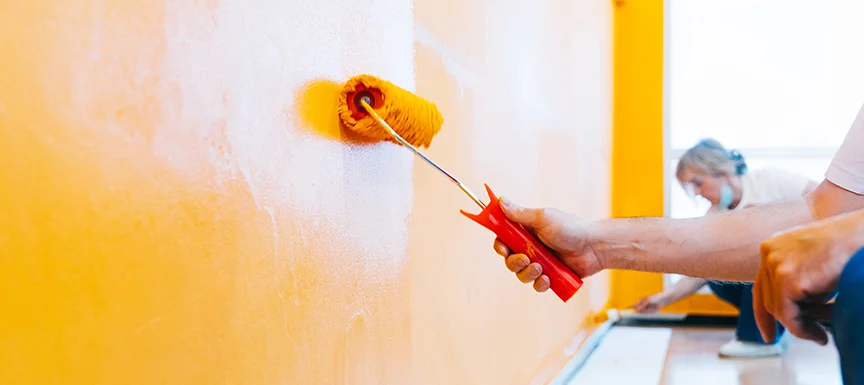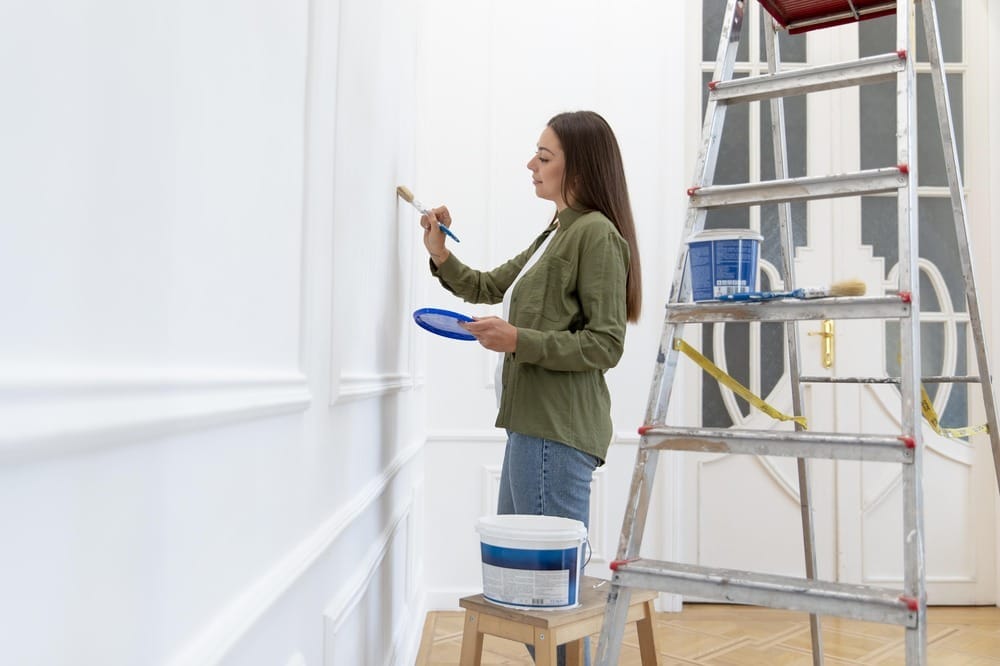Menu

Key Takeaways✔ Select paint specifically designed to withstand the unique challenges of your local climate. ✔ Ensure the surface is clean, repaired, and primed to guarantee long-lasting adhesion and durability. ✔ Invest in premium paints and tools to enhance the finish and resistance to wear. ✔ Apply paint evenly using the correct tools and techniques for maximum coverage and protection. ✔ Schedule painting during optimal weather conditions to ensure proper drying and curing. ✔ Perform regular inspections, cleaning, and touch-ups to extend the lifespan of the paintwork. |
A fresh coat of exterior paint does more than enhance your home’s curb appeal—it serves as a critical barrier against harsh weather, moisture, and UV damage. Painting your home’s exterior can add substantial value, with surveys showing it can increase resale value by over $7,500, offering an impressive return on investment.
With the right techniques and materials, exterior house painting becomes a powerful way to preserve your property while increasing its market appeal. These six practical tips ensure your home remains protected and visually stunning in any climate.
Selecting the right type of paint for a home’s exterior is essential for durability and long-term protection. Different climates demand paints with specific properties to withstand environmental challenges.
Different weather conditions impact the longevity and performance of exterior paint. Choosing the right type of paint is crucial for protection against harsh elements.
Paints are also designed to work best with specific materials, making it essential to consider the home’s exterior type.
Proper preparation is the cornerstone of a successful exterior house painting project. Ensuring surfaces are clean, smooth, and free of defects helps the paint adhere better and last longer, protecting your home from weather damage.
Cleaning and repairing surfaces are essential first steps in any exterior house painting process. Dirt, grime, mold, and mildew can prevent paint from adhering properly, while damaged surfaces may lead to uneven finishes.
Sanding and priming are vital to achieving a smooth and durable finish. These steps help to level out imperfections and provide an ideal base for paint application.
Cracks, peeling, and flaking paint can compromise the protective function of an exterior finish. Addressing these issues is particularly crucial for stucco house painting or older homes with extensive wear.
Investing in premium materials for exterior house painting can make a significant difference in the longevity and appearance of a home. High-quality paints and tools not only enhance the look of the property but also provide superior protection against environmental wear and tear.
Selecting premium-grade paint is a crucial step for any exterior painting project. These paints are specifically designed to withstand various climate conditions and offer long-lasting results.
Using high-quality tools is just as important as selecting the right paint for tasks like wood siding painting or stucco house painting. Tools designed for professional use help achieve a flawless application and improve efficiency.
Wood siding requires special attention due to its natural properties and susceptibility to weather damage. High-quality paint and tools provide an effective barrier against moisture, UV rays, and temperature fluctuations.
Stucco exteriors demand durable materials to protect against cracks and weathering. Investing in top-tier paint and tools ensures the stucco surface remains intact and visually appealing.
Exterior house painting is a crucial step in maintaining the beauty and longevity of a home. Using the correct painting techniques ensures better coverage, durability, and overall protection from harsh environmental factors.
The success of any painting project heavily depends on the tools used. Choosing the right equipment for different surfaces, such as wood siding painting or stucco house painting, can make a significant difference.
Applying multiple coats of paint is a critical step that should never be overlooked. A single coat may seem sufficient, but it often fails to provide the necessary protection and aesthetic finish, especially for challenging surfaces like wood siding.
To achieve the best results, a combination of proper tools, preparation, and application techniques is essential.
Exterior house painting requires careful consideration of the timing to ensure the best results and long-lasting protection. Proper timing prevents premature wear and helps maintain the aesthetic appeal of the home, whether it features wood siding painting or stucco house painting.
Choosing the right season is crucial for successful exterior house painting. The weather directly affects paint adhesion and drying time.
Extreme weather conditions can compromise the quality of wood siding painting, stucco house painting, and other exterior finishes. Avoid painting during unsuitable weather to protect the home effectively.
Proper planning ensures optimal results for any exterior painting project, including wood siding and stucco house painting.
Exterior house painting is not a one-time effort; it requires regular attention to maintain its protective qualities and aesthetic appeal. Routine inspections are essential to identify any wear and tear caused by environmental factors like sun, rain, or snow.
Cleaning is an integral part of maintaining exterior paint, as dirt, mold, and mildew can compromise its appearance and longevity.
Minor damages, if ignored, can escalate and require extensive repairs or repainting. Prompt action ensures the durability of the exterior house painting.
To extend the lifespan of exterior house painting, proactive measures can help shield it from environmental damage.

The amount of paint needed depends on the size of your home, the number of coats required, and the paint’s coverage rate. On average, one gallon of paint covers about 350–400 square feet of smooth surface. For a standard-sized house, you may need 10–15 gallons, including primer. Keep in mind that textured surfaces and darker color transitions may require more paint. Measure each wall and calculate the square footage to estimate your needs accurately.
Drying time depends on factors like the type of paint, weather conditions, and surface material. Most exterior paints dry to the touch within four to six hours under optimal conditions. However, full curing, where the paint reaches its maximum hardness and durability, can take up to 30 days. High humidity and low temperatures may extend drying time, while sunny and breezy conditions can speed it up. Avoid applying additional coats until the first coat is completely dry.
Choosing the right exterior paint involves considering factors like durability, finish, and compatibility with your home’s materials. Acrylic latex paints are popular because they resist fading, cracking, and mildew, making them ideal for most climates. Oil-based paints offer a smooth finish and durability but are less environmentally friendly. The finish (matte, satin, or glossy) depends on your aesthetic preference and the area being painted. Satin and semi-gloss finishes work well for trim and doors, while flat finishes are suitable for large wall surfaces.
Painting your house yourself can save money, but it requires time, effort, and the right tools. DIY is best for small, straightforward projects with accessible surfaces. Larger homes, intricate designs, or challenging heights often require professional expertise for safety and precision. Professionals bring experience, efficiency, and the ability to deliver a flawless finish. Hiring a painter also ensures that proper preparation and high-quality materials are used.
The average cost to paint the exterior of a house is approximately $3,178, with most homeowners spending between $1,819 and $4,551. The exact cost varies based on the size of the home, the type of siding, and whether you hire professionals or opt for a DIY approach. Larger homes or those with complex architectural details tend to be on the higher end of the price range. Additional expenses, such as surface repairs, multiple color choices, or special finishes, can further increase the overall cost.
Ensure your home withstands every season in West Hartford, CT, with professional exterior house painting services tailored to your needs. West Hartford House Painting Experts specialize in delivering durable, high-quality finishes for every type of surface, from wood siding painting to stucco house painting. Serving homeowners across West Hartford, CT, we prioritize precision, quality materials, and techniques designed to protect your investment.
Contact West Hartford House Painting Experts today to enhance your home’s protection and curb appeal in West Hartford, CT.
Maintain the beauty and longevity of your deck with the trusted professionals at West Hartford House Painting Experts. Offering comprehensive deck staining and restoration services, we take pride in helping homeowners in West Hartford, CT, preserve their outdoor spaces. From surface preparation to precise application, our team ensures your deck is protected from weathering and looks stunning year-round.
Serving the West Hartford, CT community, we specialize in delivering exceptional craftsmanship and personalized care tailored to your needs. Let us bring our expertise to your project and create a space you’ll enjoy for years to come.
Contact West Hartford House Painting Experts today for top-tier deck maintenance services in West Hartford, CT!

Welcome to West Hartford House Painting Experts. We believe that we are the highest quality painting company in this community and we provide excellent customer service!